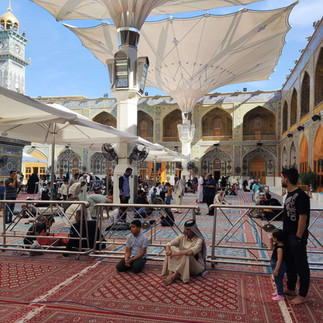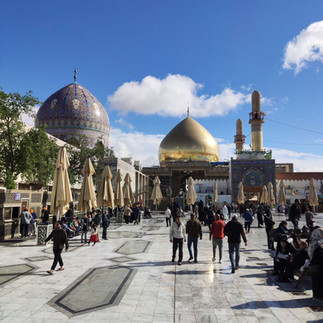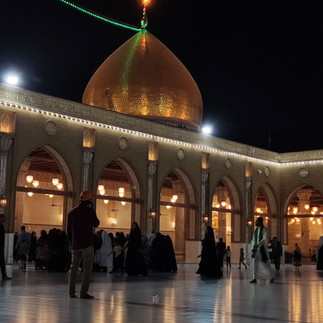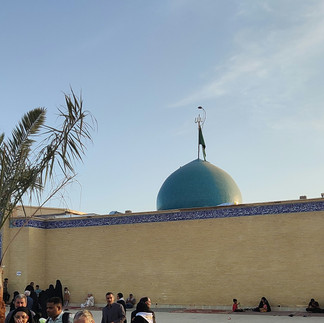Iraq Travelogue
- Abrar Baig
- Nov 26, 2023
- 6 min read
Updated: Nov 28, 2023
In the name of God, The Most Gracious, The Most Merciful.
Praise belongs to Him alone.
Peace and blessings be upon Prophet Muhammad and his family.
The idea of writing this article didn't occur to me initially, but I find myself doing it now. Thanks to the brother who suggested that I share my recent visit to Iraq in an article, with the hope that readers would be inspired to visit this Spiritual Capital, In Sha Allah.
I've strived to keep this concise while maintaining the chronological order of the visited places.
Al Najaf Al Ashraf

Najaf is the final resting place of Ali Ibn Abi Talib, the brother, son-in-law, standard bearer of the Prophet, and the lion of God, (عليهم السلام).
Upon landing in Najaf, my heart eagerly longed for a glimpse of the blessed grave of Ali. After a quick shower at the hotel, I hastened to the shrine. As I set my sight upon the dome of his blessed shrine, though my heart overflowed with love for the Imam, words couldn't fully capture it. Nevertheless, my tongue managed to convey, "As Salamu Alaika Ya Ameer Al Momineen, peace be upon you O commander of the faithful," as tears welled up in my eyes. Entering the haram, I approached the doors of the shrine, upon reaching the grave, I offered my salutations to the Prophet and Ali, and conveyed the greetings on behalf of others. Having cherished a meaningful moment at the grave of Imam Ali, I exited to perform a couple of rak'ah in the haram. The unique tranquility within the haram is something I had hoped to also experience while falling asleep therein, but unfortunately, it is not allowed.
The haram's boundary walls boast 'Iwans with beautiful calligraphy,' while the glass decorations beneath the dome are breathtaking. Cameras fail to entirely capture the splendor of this architectural marvel. The Dome, minarets, doors, and the Zarih (a metal mesh-like structure enclosing the grave) are all crafted from pure gold. The dome radiates brilliance and shines through, whether it's day or night.
Some of the virtues of Imam Ali through the blessed tongue of the Messenger of God (ﷺ)
“Whoever’s master I am, Ali is also his master”
“O Ali, you are to me as Harun was to Musa”
“Ali loves Allah and his Messenger, and Allah and his Messenger love Ali”
“Only a believer loves Ali. And only a munafiq (hypocrite) dislikes Ali”
“O Ali, You are from me and I am from you”
“Ali will fight for the (correct) interpretation of this Qur’an, just as I fought for its revelation”
“Whoever harms Ali harms me, too”
Imam Ali was also the first male to accept Islam and offer prayers with the Prophet ﷺ”
[I have cited exclusively authentic narrations above; nevertheless, the last one is subject to differing opinions regarding its authenticity.]
Karbala

Karbala requires no introduction; it is the sacred ground where numerous martyrs rest, including the chief of martyrs, the leader of the people of Jannah—Abi Abdullah Al Husayn, the beloved grandson of the Prophet, (عليهم السلام).
To this day, Imam Husayn remains the symbol of unwavering resistance against tyranny, injustice, and corruption—an unparalleled resistance that the world has never witnessed before and likely will never witness again. On the day of Ashura at Karbala, one individual, Imam Husayn, safeguarded the collective efforts of 124,000 prophets and messengers, sacrificing his life, family, friends and all that he had for the sake of God and His Messenger.
Those acquainted with the events of Karbala often weep when recalling the tragic incident that transpired on the day of Ashura in 680 AD, corresponding to 61 Hijri. It is a historical anomaly that followers of a prophet were responsible for the killing of their prophet's family—a sorrowful occurrence at Karbala. Some have a misconception that the Shia killed Imam Husayn, I would call such people ignorant of their religion and its history. In fact, Yazid and Ibn Ziyad, the perpetrators, can be associated with the Sunni sect if one employs sectarian terminology.
After spending four days in Najaf, I proceeded to Karbala. Upon reaching the hotel at 6 PM, I unfortunately developed a fever. After taking medication, I went to sleep and woke up the next morning feeling completely fine. Grateful to God. Eager as always, I hurried to offer my salams, this time to Imam Husayn. Upon entering the haram, goosebumps and tears overwhelmed me, the atmosphere was indescribable. Soon as I entered the shrine, I asked a fellow visitor, "Whose shrine is this?" He replied, "Abbas."
[FYI: Imam Husayn and Hazrat Abbas' graves are situated in the same Haram, and the area between the two is referred to as "Bayn Ul Harmain."]
The distance between the graves of Abbas and Husayn is approximately 400 meters, and interestingly, the distance between Safa and Marwa is also around 400 meters. Please refer to the photos below for visual reference.
Hazrat Abbas, the son of Imam Ali from Ummul Banin (عليهم السلام), was a warrior akin to his father. Serving as the standard bearer in Husayn's army at Karbala, he mirrored Ali, who held the same role in the Prophet's army. Just as Ali was obedient and faithful to Muhammad, Abbas displayed unwavering loyalty to his master, Husayn, (عليهم السلام).
Despite being brothers, historical accounts reveal that Abbas always referred to Husayn as his master. In a poignant moment during the Battle of Karbala, with his head on Husayn's lap, Abbas was asked by Husayn “Abbas, all your life you have called me Master. Once, brother ‘Abbas, just once, call me brother.”
Abbas, in the throes of his final breaths, uttered, “Husayn, my brother”
And then after a very short moment, departed from this world.
Abbas embodied qualities of bravery, loyalty, faithfulness, and obedience. As a beloved brother to Husayn and a son of Ali (عليهم السلام), he holds a special place in history. It has become a tradition for the Zayirs to visit Hazrat Abbas before they visit Imam Husayn, as the saying goes, ”just like Ali is the door to Muhammad, Abbas is the door to Husayn” (عليهم السلام). Unknowingly following this tradition, I found myself at Abbas's grave, thinking it was Husayn's—a fortuitous alignment with the revered custom.
Having extended my greetings to Abbas, I proceeded along Bayn Ul Haramain towards Imam Husayn's shrine. Upon entering, I performed 2 rak'ah nawafil, conveyed my salams, and extended greetings on behalf of others. The awe-inspiring shrines of both Abbas and Husayn captivate with a delightful fragrance lingering in the air. I longed for that scent to linger on my hands and garments. The indescribable beauty unfolds through glass decorations, golden gates, the golden domes, Iwans and walls adorned with calligraphy.
Describing Imam Husayn is a challenge as words seem inadequate. The oppression endured by the Ahlul Bayt deeply disturbs the hearts of the believers, may God's peace be upon Muhammad and his family and upon those who stand against tyranny, oppression and injustice.
May God aid our brothers and sisters in Palestine who are demonstrating the highest level of Imaan and resistance against oppression, may God destroy the oppressors and punish them with a terrible punishment, Aameen.
The Prophet (ﷺ) said, Husayn is from me and I am from Husayn.
Hasan and Husayn are the leaders of the people of paradise.
Hasan and Husayn are my two flowers from this world.
(Tirmidhi)
Loving Hasan and Husayn is loving me, and showing animosity towards them is showing animosity towards me.
(Mustadrak)
Baghdad

Iraq serves as a spiritual capital for the Muslims, hosting the resting places of esteemed Aimmah and Auliya. Baghdad, once a hub of learning, was not only significant for the Muslims but also for the non-Muslims. The city was referred to as Bayt Al Hikmah (The House Of Wisdom), earning recognition as a center of scientific excellence. My knowledge of Baghdad's history is limited, but I recommend the readers to explore it, In Sha Allah.
The photo above depicts Abu Hanifa Al-Numan Masjid, where the revered Imam Abu Hanifa (رحمه الله), popularly referred to as “Al Imam Al Aazam [the greatest leader]” is laid to rest.
I spent two days in Baghdad after a five-day stay in Karbala. Unfortunately, my exploration of this beautiful city was limited. On the first night, I attempted to visit the shrines of Imam Abu Hanifa and the great sufi shaykh, Abdul Qadir Jilani, who is popularly referred to as “Al Ghous Al Aazam [the greatest helper]”(رحمهم الله), but both were closed. Despite being allowed to enter the vicinity of Shaykh Abdul Qadir Jilani's shrine by the security police, my heart remained unsatisfied.
Limited exploration of Baghdad resulted from traveling to other cities during the days and returning to Baghdad in the evenings.
Nevertheless, I managed to visit Shaykh Abdul Qadir Jilani's shrine, but was still unfortunate that I couldn't visit Imam Abu Hanifa's shrine except for the vicinity of the masjid.
I also traveled to Kufa, Samarra, and Balad, making Ziyarah to the great-grandsons of the Prophet (ﷺ): Imam Musa Kazim, Imam Muhammad Taqi, Imam Hasan Al Askari, and Imam Al Naqi (عليهم السلام). I visited Masjid Kufa, Imam Ali's house, Masjid Hannana, and Masjid Sehla. Despite most of Iraq being under development, these places boast grand structures and impressive architecture.
Regarding interactions with the locals, a significant language barrier existed between us foreigners and the local population. English wasn't understood, even at the bazaar. Nevertheless, I managed with my limited Arabic. Some locals were hospitable, while others were somewhat rude.
In conclusion, I believe Iraq is a destination one must visit at least once in their lifetime. It has indeed enhanced my spirituality and strengthened my Imaan, Alhamdulillah. I hope to visit Iraq again, and may Allah make it easy for the believers to perform Hajj, Umrah, and Ziyarah to these blessed places, Aameen.
That concludes it. I'll see you in the next article, In Sha Allah. Until then, Assalamu Alaikum Wa Rahmatullahi Wa Barakatuh.




































































Comments